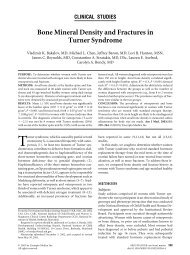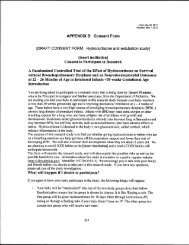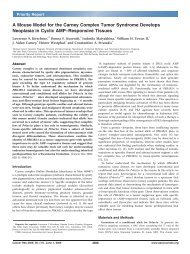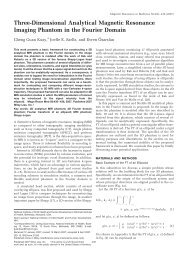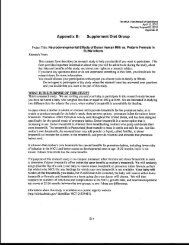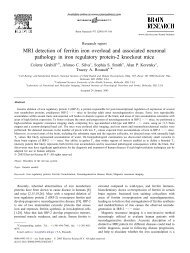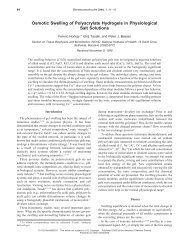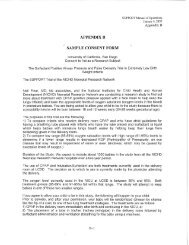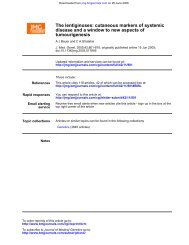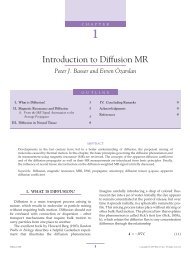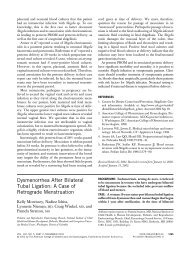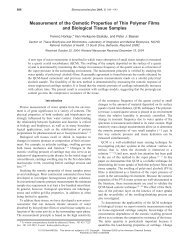Stimulation of a myelinated nerve axon by electromagnetic induction
Stimulation of a myelinated nerve axon by electromagnetic induction
Stimulation of a myelinated nerve axon by electromagnetic induction
Create successful ePaper yourself
Turn your PDF publications into a flip-book with our unique Google optimized e-Paper software.
Biomedical engineering<br />
<strong>Stimulation</strong> <strong>of</strong> a <strong>myelinated</strong> <strong>nerve</strong> <strong>axon</strong> <strong>by</strong><br />
<strong>electromagnetic</strong> <strong>induction</strong><br />
P. J. Basser B. J. Roth<br />
Biomedical Engineering & Instrumentation Program, National Center <strong>of</strong> Research Resources, <br />
National Institutes <strong>of</strong> Health, Building 13, Room 3W13, Bethesda, MD 20892, USA <br />
Abstract-A model <strong>of</strong> <strong>electromagnetic</strong> stimulation predicts the transmembrane<br />
potential distribution along a <strong>myelinated</strong> <strong>nerve</strong> <strong>axon</strong> and the volume <strong>of</strong> stimulated<br />
tissue within a limb. Threshold stimulus strength is shown to be inversely proportional<br />
to the square <strong>of</strong> the <strong>axon</strong> diameter. It is inversely proportional to pulse duration for<br />
short pulses and independent <strong>of</strong> pulse duration for lone ones. These results are also<br />
predicted <strong>by</strong> dimensional analysis. Two dimensionless numbers, Sem• the ratio <strong>of</strong> the<br />
induced transmembrane potential to the <strong>axon</strong>'s threshold potential, and TcfT. the ratio<br />
<strong>of</strong> the pulse duration to the membrane time constant, summarise the dependence <strong>of</strong><br />
threshold stimulus strength on pulse duration and <strong>axon</strong> diameter.<br />
Keywords-Electromagnetic <strong>induction</strong>, Magnetic stimulation, Mathematical model,<br />
Peripheral <strong>nerve</strong>, Scaling laws. Threshold<br />
Med. & Bioi. Eng. & Comput., 1991, 29, 261-268<br />
1 Introduction<br />
OUR GOAL is to explain the remarkable observation that<br />
<strong>myelinated</strong> <strong>axon</strong>s can be stimulated <strong>by</strong> <strong>electromagnetic</strong><br />
<strong>induction</strong> (BICKFORD and FREMMING, 1965; POLSON et a/.<br />
1982). It is possible to excite a neuron <strong>by</strong> passing a timevarying<br />
current through a wire coil (Fig. 1). Magnetic<br />
stimulation, as this is sometimes called, is noninvasive and<br />
relatively painless; it is useful in diagnosing neurological<br />
disorders such as multiple sclerosis, and for evoking motor<br />
Fig. 1<br />
s<br />
Llo--------'c<br />
0<br />
current stimulator<br />
First received 18th April and in final form 12th July 1990<br />
© IFMBE: 1991<br />
stimulating<br />
I<br />
Schematic diagram <strong>of</strong> the cylindrical limb, <strong>nerve</strong> <strong>axon</strong> and<br />
stimulating circuit. The coil radius rc is 4·5 em and the<br />
limb radius is 3 em. When S is switched to the left, the<br />
capacitor C charges to a voltage V 0 . When S is to the<br />
right, the capacitor discharges through a resistance R and<br />
inductance L, creating the current pulse I ( t) in the coil<br />
responses (HALLETT and COHEN, 1989). Although commonly<br />
used for transcranial activation <strong>of</strong> the cortex, <strong>electromagnetic</strong><br />
stimulation has not gained wide acceptance<br />
for peripheral <strong>nerve</strong> stimulation, in part, because <strong>of</strong> uncertainty<br />
in the site <strong>of</strong> excitation (EVANS et al. 1988; CHOKRO-<br />
VERTY, 1989).<br />
In this paper we present a mathematical model <strong>of</strong> <strong>electromagnetic</strong><br />
stimulation <strong>of</strong> a mammalian peripheral <strong>nerve</strong><br />
<strong>axon</strong> within a limb. We calculate the electric field induced<br />
within a cylindrical volume conductor and the resulting<br />
transmembrane potential along an <strong>axon</strong>. This model predicts<br />
the location <strong>of</strong> the volume <strong>of</strong> stimulation within a<br />
limb as well as the dependence <strong>of</strong> threshold stimulus<br />
strength on pulse duration and <strong>axon</strong> diameter. Finally, we<br />
derive a simple relationship between the dimensionless<br />
stimulus strength and pulse duration which concisely summarises<br />
the scaling laws governing the threshold response<br />
<strong>of</strong> the <strong>axon</strong>.<br />
2 Methods<br />
This description <strong>of</strong> <strong>electromagnetic</strong> stimulation <strong>of</strong> an<br />
<strong>axon</strong> consists <strong>of</strong> three parts. The current in the stimulating<br />
coil is predicted <strong>by</strong> an RLC circuit model. The electric field<br />
induced in a cylindrical limb is calculated using Maxwell's<br />
equations (ROTH et al., 1990). The distribution <strong>of</strong> transmembrane<br />
potential along the <strong>axon</strong> is determined from a<br />
cable model. The coupling between the induced electric<br />
field and the transmembrane potential appears as a single<br />
term in the cable equation, a term that we previously<br />
derived to describe stimulation <strong>of</strong> un<strong>myelinated</strong> <strong>axon</strong>s<br />
(Rom and BASSER, 1990). To represent a myelirutted <strong>axon</strong>,<br />
we use a cable model whose nodal membrane dynamics<br />
were measured <strong>by</strong> CHIU et al. (1979), and anatomical<br />
scaling relationships derived <strong>by</strong> RuSHTON (1951) for <strong>axon</strong>s<br />
with different diameters.<br />
Medical &. Biological Engineering &. Computing May 1991<br />
261
2.1 The current pulse waveform<br />
In most commercial <strong>electromagnetic</strong> stimulators, a<br />
current pulse l(t) is generated <strong>by</strong> discharging a capacitor C<br />
whose initial voltage is V 0 through a coil having resistance<br />
R and inductance L (Fig. 1). If the RLC circuit is overdamped,<br />
dl(t)/dt is given <strong>by</strong><br />
dl(t) V<br />
t L W2<br />
-d =- 0 e-w (<br />
1 W1 . )<br />
where the frequencies w 1 and w 2 are<br />
1 ~<br />
t cosh (w 2 t)-- smh (w 2 t) (1)<br />
w = and w = J(~) 2 (2)<br />
2L<br />
2<br />
1<br />
2L LC<br />
Table 1 contains the values <strong>of</strong> R, L and C used in these<br />
calculations. They approximate the current waveform <strong>of</strong><br />
an existing magnetic stimulator (BARKER et al., 1985).<br />
The voltage-dependent rate constants are given (in ms- 1 )<br />
<strong>by</strong><br />
126 + 0·363V <br />
am(V)= (-(V+49))<br />
1·0+exp .<br />
Pm(V} = (V + 56·2)<br />
exp 4·17<br />
5 3<br />
(6)<br />
data obtained <strong>by</strong> CHIU et al. (1979) from voltage clamp<br />
experiments with rabbit <strong>myelinated</strong> <strong>axon</strong>s. These values<br />
were taken from SWEENEY et al. (1987)*, who adjusted<br />
Cmu et al.'s (1979) results from 14° to 37oC. No potassium<br />
current is included in expression 4, which is consistent with<br />
the observation <strong>by</strong> Cmu et al. (1979) that potassium channels<br />
are absent from the nodal membrane <strong>of</strong> mammalian<br />
<strong>myelinated</strong> <strong>axon</strong>s.<br />
The nodes are joined <strong>by</strong> lengths <strong>of</strong> passive <strong>axon</strong> which<br />
are insulated <strong>by</strong> a myelin sheath (Fig. 3a). In the internodal<br />
region, the transmembrane potential is governed <strong>by</strong><br />
a cable equation<br />
15·6<br />
ph(V) = ( (V + 56))<br />
1 + exp -<br />
10<br />
where V is the transmembrane potential (in mV). The<br />
nodal capacitance per unit area c", the sodium conductance<br />
per unit area 9Na, the leak conductance per unit area<br />
gL, the sodium Nernst potential ENa• the leak Nernst<br />
potential EL and the channel gating kinetics are based on<br />
<strong>axon</strong>al node <strong>of</strong> <br />
membrane Ranvier 1\<br />
lEL LNal<br />
Cn<br />
gl 9Na<br />
axoplasm myelin<br />
a<br />
lvr<br />
l<br />
L<br />
sheath<br />
(7)<br />
Cm<br />
rm<br />
-- V(x) - +--8x---<br />
I i (x) I i (x•L'l x)<br />
node <strong>of</strong> Ranvier <strong>myelinated</strong> membrane<br />
Fig. 3 (a) Cross-section <strong>of</strong> a <strong>myelinated</strong> <strong>nerve</strong> <strong>axon</strong>. The <strong>axon</strong>al<br />
b<br />
2 o 2 V av 2 oex(x, t)<br />
Amye ox2 - tmye dt- (V- V,.) = Amye OX (8)<br />
The space constant <strong>of</strong> the internodal region Amye is defined<br />
<strong>by</strong><br />
A =d. Pmye (9)<br />
mye ' 8p n d.<br />
There are several differences between our work and the abstract <strong>by</strong><br />
swEENEY eta/. (1987). First, they express the units <strong>of</strong> g,;. and gL in<br />
'Sjcm 2 '; but to be consistent with CHIU et a/. (1979) the same<br />
numbers should have been given in 'mSjcm 2 ' (e.g. the correct<br />
maximum sodium conductance per unit area is 1445 mSjcm 2 ). Secondly,<br />
in the definition <strong>of</strong> am, SWEENEY et a/. express the argument <strong>of</strong><br />
the exponential as '-{V+49)j53', whereas it should be given as<br />
'-(V + 49)/5·3'.<br />
I (d•)<br />
a '<br />
(FITZHUGH, 1969) and the time constant tmye <strong>by</strong><br />
(10)<br />
where Pmye and Pa are the resistivities <strong>of</strong> myelin and axoplasm,<br />
respectively, K is the dielectric constant <strong>of</strong> myelin, e 0<br />
is the permittivity <strong>of</strong> a vacuum, d. is the outer diameter <strong>of</strong><br />
the myelin sheath and d; is the diameter <strong>of</strong> the <strong>axon</strong>al<br />
membrane. The rest potential V,. is - 80 mV; Cmu and<br />
RITCHIE (1984) contend that potassium ion channels<br />
beneath the myelin sheath maintain a uniform resting<br />
potential throughout the internodal region. We also<br />
assume that the resistance <strong>of</strong> the extracellular space is negligible,<br />
which may not be valid for <strong>axon</strong>s that are tightly<br />
packed in a <strong>nerve</strong> bundle where a more detailed model<br />
may be needed (ALTMAN and PLONSEY, 1988).<br />
The distributed cable equation (eqn. 8) is solved explicitly<br />
for the entire <strong>axon</strong>. At a node, eqns. 4-7 are included<br />
as an additional source <strong>of</strong> transmembrane current; no auxiliary<br />
equations are needed as in FITZHUGH (1962) to guarantee<br />
that current is continuous at the node.<br />
During <strong>electromagnetic</strong> stimulation, the <strong>axon</strong> first fires<br />
where the negative gradient <strong>of</strong> the component <strong>of</strong> the electric<br />
field in the axial direction reaches a maximum.<br />
We previously derived a source term <strong>of</strong> the form<br />
-A. 2 oex(x, t)jox in the cable equation <strong>of</strong> an un<strong>myelinated</strong><br />
<strong>axon</strong> which specifies how the induced electric field gives<br />
rise to a transmembrane current (RoTH and BASSER, 1990).<br />
Once the <strong>electromagnetic</strong> source term is prescribed,<br />
formal analogies can be drawn between <strong>electromagnetic</strong><br />
stimulation and stimulation <strong>by</strong> a microelectrode or extracellular<br />
electrodes <strong>by</strong> comparing their respective dynamic<br />
equations. For stimulation with extracellular electrodes,<br />
membrane contains active regions, nodes <strong>of</strong> Ranvier, that<br />
are joined <strong>by</strong> passive segments insulated <strong>by</strong> myelin. Nodes<br />
are spaced a distance A apart and are owide. The <strong>axon</strong><br />
has an outer diameter <strong>of</strong> d. and an inner diameter <strong>of</strong> d;.<br />
(b) Distributed-circuit model <strong>of</strong> a <strong>myelinated</strong> <strong>axon</strong>. At the<br />
node the membrane current per unit length im(x) flows<br />
through either the nodal membrane capacitance c. or the<br />
sodium or leak channels. Ohm's law relates the axial intra<br />
cellular current I;( x) to the intracellular electric field; the<br />
equation <strong>of</strong> continuity relates l;(x) to the membrane<br />
current per unit length im(x); The intracellular resistance<br />
per unit length is r; ; the extracellular resistance is zero.<br />
The capacitance per unit length <strong>of</strong> the myelin is em; the<br />
resistance length <strong>of</strong> the myelin is rm. EL and EN. are the<br />
leakage and sodium Nernst potentials, respectively; gLand<br />
gNa are the leakage and sodium conductances, respectively.<br />
The batteries V,. represent the action <strong>of</strong> active pumps and<br />
channels beneath the myelin that maintain the resting<br />
potential <strong>of</strong>the membrane at -80 m V<br />
oexfox is replaced <strong>by</strong> - o 2 Ve/ox 2 in eqn. 8, where V., is the<br />
extracellular potential developed <strong>by</strong> the electrodes<br />
(RATTAY, 1986; 1988). For stimulation with an intracellular<br />
microelectrode, oexfox is replaced <strong>by</strong> - r; ip in eqn. 8,<br />
where iP is the inward applied current per unit length and<br />
r; is the resistance per unit length <strong>of</strong> the axoplasm<br />
(PLONSEY, 1969).<br />
Medical & Biological Engineering & Computing May 1990 263<br />
*
RUSHTON (1951) postulated three scaling relationships<br />
for <strong>myelinated</strong> <strong>axon</strong>s <strong>of</strong> different diameters, which have<br />
been verified experimentally (GoLDMAN and ALBUS, 1968).<br />
First, the distance between nodes varies linearly with <strong>axon</strong><br />
diameter. Experimental data suggest that the node spacing<br />
is about 100 times the myelin outer diameter, although this<br />
relationship does not hold for an <strong>axon</strong> whose diameter is<br />
less than 4,um (RITCmE, 1982)<br />
L<br />
- = 100 (11)<br />
do<br />
Secondly, the ratio <strong>of</strong> the inner and outer diameters <strong>of</strong> the<br />
myelin sheath is constant,<br />
d.<br />
___!. = 0·6 (12)<br />
do<br />
Thirdly, the width <strong>of</strong> the node b is independent <strong>of</strong> <strong>axon</strong><br />
size (FITZHUGH, 1969). We choose b = 1·5,urn (SWEENEY et<br />
al., 1987).<br />
The system <strong>of</strong> nonlinear partial differential equations,<br />
eqns. 4-12, is solved numerically on a Cray XMP-24<br />
(ASCL, National Cancer Institute, Frederick, Maryland)<br />
using the method <strong>of</strong> lines-a finite element algorithm<br />
(IMSL Scientific Subroutine Library). The membrane is<br />
initially at rest, i.e. V(x, 0) = V,.; both ends <strong>of</strong> the <strong>axon</strong> are<br />
assumed to be sealed.<br />
We define threshold stimulus strength in the following<br />
way: we determine when and where along the <strong>axon</strong> the<br />
stimulus strength -oex(x, t)jox reaches a maximum value<br />
(in the previous example at x = - 2·5 em at t = 0). The<br />
threshold stimulus strength is the minimum value <strong>of</strong> this<br />
quantity that is sufficient to elicit an action potential.<br />
Threshold stimulus strength is determined to within ±0·5<br />
per cent using a binary search algorithm. <strong>Stimulation</strong><br />
usually occurs when the membrane is depolarised from<br />
rest <strong>by</strong> about 20mV or to V = -60mV.<br />
For a set <strong>of</strong> current pulses with the same duration,<br />
threshold stimulus strength is proportional to the initial<br />
voltage on the capacitor in the stimulating circuit V 0 • Fig.<br />
5 shows the predicted relationship between V 0 and the<br />
outer diameter <strong>of</strong> the <strong>axon</strong> do . The <strong>axon</strong> lies 0·15 em below<br />
the surface <strong>of</strong> the limb. A regression line was fitted to the<br />
data; it was found to have a slope <strong>of</strong> -2·01 and a coefficient<br />
<strong>of</strong> correlation <strong>of</strong> 0·9997. The model predicts that<br />
threshold stimulus strength is inversely proportional to the<br />
square <strong>of</strong> the <strong>axon</strong> diameter.<br />
10 5 \<br />
3 Results<br />
Fig. 4 shows a contour plot <strong>of</strong> the transmembrane<br />
potential as a function <strong>of</strong> the distance x along the <strong>axon</strong><br />
and the time t after the onset <strong>of</strong> the stimulus for a <strong>axon</strong><br />
with an outer diameter <strong>of</strong> 20 ,urn. The plane x = 0 is perpendicular<br />
to the <strong>axon</strong> and passes through the centre <strong>of</strong><br />
the coil. The <strong>axon</strong> is assumed to lie 0·15 em below the top<br />
surface <strong>of</strong> the limb. After a latency <strong>of</strong> approximately 0·15<br />
ms, two action potentials develop, propagating in opposite<br />
directions with speeds <strong>of</strong> about 66 m s- 1 • The origin <strong>of</strong><br />
stimulation, x = -2·5cm, corresponds to the position<br />
where -oex(x,t)/ox reaches a maximum. Membrane<br />
hyperpolarisation is greatest at x = +2·5 em where<br />
-oe:x:(x, t)/ox is a minimum. Although x = 0 is the position<br />
where e"'(x, t) reaches a maximum, -oe:x:(x, t)iox vanishes<br />
there. The V = 0 contour shows that the travelling wave<br />
front rises faster than it falls.<br />
Ill<br />
-·<br />
E 1·0<br />
0·5<br />
x,cm<br />
Fig. 4 Contour plot <strong>of</strong> the transmembrane potential along a 20 Jl.m<br />
<strong>axon</strong> located 0·15 em below the surface <strong>of</strong> the limb, in<br />
response to a suprathreshold stimulus (V 0 = 160(1 V). The<br />
origin <strong>of</strong> stimulation is at x = - 2·5 em while the latency is<br />
approximately 0·15 ms<br />
10 3 L---------------~~--------------_J<br />
10-4 10-3 10-2<br />
<strong>axon</strong> diameter, em<br />
Fig. 5 Threshold capacitor voltage required to stimulate <strong>axon</strong>s <strong>of</strong><br />
different diameters. The stimuli have different amplitudes<br />
but the same durations. A regression line was fitted to the<br />
data; it has a slope <strong>of</strong> -2·01 and a coefficient <strong>of</strong> correlation<br />
<strong>of</strong> 0·9997, indicating that threshold voltage is<br />
inversely proportional to the square <strong>of</strong> the <strong>axon</strong> diameter<br />
(R = 0·47il, L = 20J1.H, C = 3100J1.F, <strong>axon</strong> depth<br />
=0·15cm)<br />
The temporal envelope <strong>of</strong> -oe"'(x,t)/ox also influences<br />
whether or not the <strong>axon</strong> is stimulated. The relationship<br />
between threshold stimulus strength and pulse duration 'c<br />
is shown in Fig. 6 for three different <strong>axon</strong> diameters.<br />
Experimentally, 'c can be varied independently <strong>of</strong> the<br />
stimulus strength <strong>by</strong> altering R or C. In generating Fig. 6,<br />
L was kept constant while R and C were chosen to keep<br />
the damping factor <strong>of</strong> the circuit (R/2) JC7L unchanged,<br />
there<strong>by</strong> making the set <strong>of</strong> applied current pulses selfsimilar.<br />
Threshold stimulus strength asymptotically<br />
approaches a constant value for long duration pulses and<br />
is inversely proportional to duration for short pulses.<br />
It is <strong>of</strong> great clinical value and scientific interest to determine<br />
the regions <strong>of</strong> excitation within a tissue mass following<br />
<strong>electromagnetic</strong> stimulation. We call this region the<br />
'volume <strong>of</strong> stimulation' (RATTAY, 1987). It is bounded <strong>by</strong><br />
surfaces along which oe"'(x, y, z, 0)/ox = -682mV em - 2<br />
(Fig. 7a). Within the volume <strong>of</strong> stimulation <strong>axon</strong>s whose<br />
outer diameters are 20 ,urn or larger will be excited. The<br />
volume <strong>of</strong> stimulation has two lobes, one below the circular<br />
coil but displaced from its centre and the other oriented<br />
almost perpendicular to the plane <strong>of</strong> the coil. Fig. 7b shows<br />
transverse sections <strong>of</strong> the limb in which the volume <strong>of</strong><br />
stimulation is shown in black. Note that no stimulation<br />
264 Medical & Biological Engineering & Computing May 1991
occurs along the transverse plane x = 0 because the axial<br />
electric field gradient vanishes there <strong>by</strong> symmetry. Ifblocking,<br />
rather than initiating, <strong>nerve</strong> conduction was <strong>of</strong> interest,<br />
the regions <strong>of</strong> tissue hyperpolarisation could be<br />
calculated and displayed in an analogous fashion.<br />
As x and rc both have units <strong>of</strong> em, the new variable x is<br />
dimensionless. Similarly, time t is normalised <strong>by</strong> the stimulus<br />
duration •c<br />
(17)<br />
The axial electric field gradient (oex(x, t)fox) is scaled <strong>by</strong> its<br />
extreme value (oexfoxmax) with respect to both space and<br />
time<br />
oex(x, t)<br />
oex(x, t) ox<br />
ox oex<br />
OX max<br />
(18)<br />
and the deviation <strong>of</strong> the transmembrane potential from its<br />
resting value is normalised <strong>by</strong> the change in potential<br />
required to elicit an action potential-its threshold potential<br />
VT,<br />
V-V.:<br />
V=---' (19)<br />
VT<br />
We substitute these normalised variables into the cable<br />
equation to obtain<br />
( ~) 2 0 2 ~ _ (~) oV _ V = (A. 2 (oex) ) oex(x, t)<br />
rc OX Lc ot VT OX max OX<br />
(20)<br />
The behaviour <strong>of</strong> this normalised cable equation is determined<br />
<strong>by</strong> the three dimensionless parameters enclosed in<br />
parentheses. In most applications <strong>of</strong> <strong>electromagnetic</strong><br />
stimulation, the square <strong>of</strong> the ratio <strong>of</strong> the length constant<br />
and the coil radius is in the order <strong>of</strong> 10- 3 , so that the first<br />
term on the left hand side <strong>of</strong> eqn. 20 is negligible. Therefore,<br />
the transmembrane potential is determined <strong>by</strong> the<br />
two remaining dimensionless parameters in eqn. 20. We<br />
define T as the ratio <strong>of</strong> the membrane time constant and<br />
stimulus duration; we call the dimensionless parameter on<br />
the right hand side <strong>of</strong> eqn. 20 the <strong>electromagnetic</strong> stimulation<br />
number sem<br />
expression for Sem and the regrouping <strong>of</strong> terms gives<br />
(<br />
s = 15 p 1 do<br />
em { PagL{J + 652 _a_ VT OX max<br />
Pmye<br />
2 (<br />
oex ) ) (23)<br />
If we assume that the physical properties <strong>of</strong> myelin and<br />
axoplasm, and the node width, are all independent <strong>of</strong> <strong>axon</strong><br />
diameter (FITZHUGH, 1969), the term within brackets on<br />
the right hand side <strong>of</strong> eqn. 23 must be constant, i.e. independent<br />
<strong>of</strong> <strong>axon</strong> size (using our parameters it equals<br />
14400). Rushton's 'principle <strong>of</strong> corresponding states' (i.e.<br />
corresponding parts <strong>of</strong> <strong>myelinated</strong> <strong>axon</strong>s <strong>of</strong> different diameter<br />
are equipotential) implies that the threshold potential<br />
VT also does not vary with <strong>axon</strong> size (RusHTON, 1951).<br />
Therefore, for a constant stimulus duration, we conclude<br />
that<br />
(24)<br />
We again use the nondimensional cable equation to<br />
explain the strength/duration data shown in Fig. 6. We<br />
neglect the term in eqn. 20 containing the small parameter<br />
A.frc and evaluate the cable equation at the position where<br />
oexfox is maximum. Recalling that oeJox is proportional<br />
to dl(t)fdt, we obtain<br />
ov<br />
-T--V= S e-r,rott<br />
ot em<br />
x (cosh (rc w 2 t)- :: sinh (rc w 2 t)) (25)<br />
Given that the transmembrane potential is initially at rest<br />
(V(O) = 0), we can solve this equation analytically, finding<br />
V(t) = -Sem {[ !X _ P<br />
p - rx 1 - Trx 1 - TP<br />
J<br />
x e-t/T- rx e-at+ p e-Pt} (26)<br />
1- Trx 1- TP<br />
(21)<br />
For a stimulus whose duration is long with respect to the<br />
<strong>axon</strong> time constant (i.e., a rheobase stimulus r ~ rc) Sem is<br />
the ratio <strong>of</strong> the magnitude <strong>of</strong> the induced transmembrane<br />
potential A. 2 (oeJoxmax) and the <strong>axon</strong>'s intrinsic threshold<br />
potential VT. sem is less than one for subthreshold stimuli<br />
and greater than one for suprathreshold stimuli. We can<br />
use this threshold condition, sem = 1, to make an a priori<br />
estimate <strong>of</strong> the magnitude <strong>of</strong> the minimum applied electric<br />
field gradient sufficient to stimulate a 20 pm <strong>myelinated</strong><br />
<strong>axon</strong> (A.= 0·234cm, VT = 20mV, sem = 1)<br />
oex(x, t)) ~ v~ = 365 m ~ (22)<br />
( ox max A. em<br />
This estimated value is within a factor <strong>of</strong> two <strong>of</strong> the threshold<br />
stimulus strength calculated numerically for a 20 pm<br />
<strong>axon</strong>, 682mV cm- 2 •<br />
Using eqn. 20, we can also explain why the threshold<br />
stimulus strength is inversely proportional to the outer<br />
diameter <strong>of</strong> the <strong>axon</strong>, as shown in Fig. 5. The substitution<br />
<strong>of</strong> the definition <strong>of</strong> the length constant, eqn. 14, into the<br />
266<br />
E <br />
where two new dimensionless parameters, ex and p, are<br />
related to the time course <strong>of</strong> the current pulse ex =<br />
t"c{w 1 - w 2 ) and P= t"c{w 1 + w 2 ). Varying ex and Pto keep<br />
the damping factor constant, we determine the value <strong>of</strong> sem<br />
required for V(t) to reach a maximum value <strong>of</strong> 1 using eqn.<br />
26 and evaluate the dimensionless duration, rJr = 1/T,<br />
using eqn. 3. These equations predict the strength/duration<br />
curve shown as a solid curve in Fig. 8. Juxtaposed are the<br />
numerical data obtained using the full nonlinear model.<br />
The curve does not have the classical 1/(1 - e-IIT) form<br />
which is appropriate for electrical stimulation with rectangular<br />
current pulses (GEDDES, 1988)---the transition<br />
from long to short durations is wider. Good agreement is<br />
seen between the theoretical and numerical results. Thus,<br />
the simplified model concisely summarises the results <strong>of</strong><br />
many numerical experiments.<br />
This model <strong>of</strong> <strong>electromagnetic</strong> stimulation depends on<br />
several assumptions which must still be examined with<br />
great care. For instance, we assume the limb is a homogeneous<br />
cylindrical volume conductor containing a homogeneous<br />
<strong>axon</strong> oriented parallel to the axis <strong>of</strong> the limb. We<br />
also assume that the induced transmembrane potential<br />
depends only on the axial position along the <strong>axon</strong> and<br />
does not vary over the <strong>axon</strong> cross-section. The validity <strong>of</strong><br />
these assumptions can only be ascertained <strong>by</strong> a more<br />
detailed three-dimensional analysis. For now, we must be<br />
cautious in using this model to interpret in vivo experimental<br />
results.<br />
This model could be used to address any interaction <strong>of</strong><br />
low-frequency <strong>electromagnetic</strong> fields with electrically active<br />
tissue. For instance, in magnetic resonance imaging the<br />
rapidly varing gradient magnetic fields can induce electric<br />
fields in the body that give rise to sensory stimulation<br />
(COHEN et al., 1990b). Another application is in health<br />
physics. The model can be used to calculate the induced<br />
electric fields caused <strong>by</strong> high-voltage power lines.<br />
Finally, as an aside, if the <strong>axon</strong> were to follow a sinuous<br />
path within the tissue or be oriented skew to the plane <strong>of</strong><br />
the coil, it is still possible to calculate the induced electric<br />
field in the direction <strong>of</strong> the <strong>axon</strong>. The trajectory <strong>of</strong> the<br />
<strong>axon</strong> can be represented as a space curve that is parameterised<br />
<strong>by</strong> its arc-length s i.e. r = r(s), where r is the displacement<br />
vector which points to an element <strong>of</strong> the <strong>axon</strong><br />
dr(s). For simplicity, the origin <strong>of</strong> this co-ordinate system<br />
is the same one used to describe the electric field. In eqn.<br />
20, -(oexfox) is replaced <strong>by</strong><br />
~<br />
a ds<br />
dr(s) )<br />
- os E(r(s), t) • Id~)I<br />
5 Conclusion<br />
(27)<br />
This model <strong>of</strong> magnetic stimulation makes several testable<br />
predictions about the action <strong>of</strong> an induced <strong>electromagnetic</strong><br />
field on an <strong>axon</strong>. By using Maxwell's equations<br />
and a cable equation we have explained why an <strong>axon</strong> is<br />
stimulated <strong>by</strong> <strong>electromagnetic</strong> <strong>induction</strong>-the induced<br />
axial electric field gradient causes a depolarising current to<br />
flow across the <strong>axon</strong>al membrane. The origin <strong>of</strong> stimulation<br />
occurs where the negative induced electric field gradient<br />
is a maximum along the <strong>axon</strong>. Relationships between<br />
threshold stimulus strength, <strong>axon</strong> diameter and pulse<br />
duration, and the locus <strong>of</strong> the volume <strong>of</strong> stimulation, can<br />
be used to predict whether an <strong>axon</strong> will be stimulated<br />
<strong>electromagnetic</strong>ally.<br />
Acknowledgments-We would like to thank Ge<strong>of</strong>f Sobering for<br />
his help in producing Fig. 7. We are also grateful to Drs Mark<br />
Hallett and Leonardo Cohen for their encouragement. We wish<br />
to thank lchiji Tasaki for enjoyable discussions and acknowledge<br />
the contribution <strong>of</strong> the National Cancer Institute for allocation<br />
<strong>of</strong> computing time and staff support at the Advanced Scientific<br />
Computing Laboratory at the Frederick Cancer Research Facility.<br />
References<br />
ALTMAN, K. W. and PLONSEY, R. (1988) Development <strong>of</strong> a model<br />
for point source electrical fibre bundle stimulation. Med. &<br />
Bioi. Eng. & Comput., 26, 466-475.<br />
ANDRIETTI, F. and BERNARDINI, G. (1984) Segmented and 'equivalent'<br />
representation <strong>of</strong> the cable equation. Biophys. J., 46, 615-<br />
623.<br />
BARKER, A. T., JALINOUS, R. and FREESTON, I. L. (1985) Noninvasive<br />
magnetic stimulation <strong>of</strong> human motor cortex. Lancet,<br />
1, 1106-1107.<br />
BICKFORD, R. G. and FREMMING, B. D. (1965) Neuronal stimulation<br />
<strong>by</strong> pulsed magnetic fields in animals and man. Dig. 6th<br />
Int. Conf. Med. Electronics Bioi. Eng., 112.<br />
Cmu, S. Y., RITCHIE, J. M., ROGART, R. B. and STAGG, D. (1979)<br />
A quantitative description <strong>of</strong> membrane currents in rabbit<br />
<strong>myelinated</strong> <strong>nerve</strong>. Land. J. Physiol., 292, 149-166.<br />
Cmu, S. Y. and RITCIDE, J. M. (1984) On the physiological role <strong>of</strong><br />
internodal potassium channels and the security <strong>of</strong> conduction<br />
in <strong>myelinated</strong> <strong>nerve</strong> fibres. Proc. R. Soc. Land. B, 220, 415-422.<br />
CHOKROVERTY, S. (1989) Magnetic stimulation <strong>of</strong> the human peripheral<br />
<strong>nerve</strong>s. Electromyogr. Clin. Neurophysiol., 29,409-416.<br />
CoHEN, L. G., RoTH, B. J., NILssoN, J., DANG, N., PANIZZA, M.,<br />
BANDINELLI, S., FRIAUF, W. and HALLETT, M. (1990a) Effect <strong>of</strong><br />
coil design on delivery <strong>of</strong> focal magnetic stimulation. I. Technical<br />
considerations. Electroenceph. Clin. Neutrophysiol., 75, 350-<br />
357.<br />
COHEN, M. S., WEISSKOPF, R. 0., RZEDZIAN, H. L. and KANTOR,<br />
H. L. (1990b) Sensory stimulation <strong>by</strong> time-varying magnetic<br />
fields. Magn. Reson. Med., 14, 409-414.<br />
EVANS, B. A., LITCHY, W. J. and DAUBE, J. R. (1988) The utility <strong>of</strong><br />
magnetic stimulation for routine peripheral <strong>nerve</strong> conduction<br />
studies. Muscle & Nerve, 11, 1074-1078.<br />
FITZHUGH, R. (1962) Computation <strong>of</strong> impulse initiation and saltatory<br />
conduction in a <strong>myelinated</strong> <strong>nerve</strong> fiber. Biophys. J., 2,<br />
11-21.<br />
FITZHUGH, R. (1969) Mathematical models <strong>of</strong> excitation and propagation<br />
in <strong>nerve</strong>. In Biological engineering. ScHWAN, H. (Ed.),<br />
McGraw-Hill, 1-83.<br />
GEDDES, L. A. (1988) Optimal stimulus duration for extracranial<br />
cortical stimulation. Neurosurg., 20, 94-99.<br />
GOLDMAN, L., and ALBUS, J. S. (1968) Computation <strong>of</strong> impulse<br />
conduction in <strong>myelinated</strong> fibers: theoretical basis <strong>of</strong> the<br />
velocity-diameter relation. Biophys. J., 8, 596-607.<br />
HALLETT, M. and COHEN, L. G. (1989) Magnetism: a new method<br />
for stimulation <strong>of</strong> <strong>nerve</strong> and brain. JAMA, 262, 538-541.<br />
KELLER, J. B. (1977) Effective behavior <strong>of</strong> heterogeneous media,<br />
In Statistical mechanics and statistical methods. In Theory and<br />
applications. LANDMAN, U. (Ed.) Plenum Press, New York, 631-<br />
644.<br />
KELLER, J. B. (1980) Darcy's law for flow in porous media and the<br />
two-space method. In Nonlinear partial equations. In Engineering<br />
and applied science, STERNBERG, R. L., KALINOWSKI, A. J.<br />
and PAPADAKIS, J. S. (Eds.) Marcel Dekker, New York, 429-<br />
443.<br />
PLONSEY, R. (1969) Bioelectric phenomena. McGraw-Hill, New<br />
York.<br />
PoLSON, M. J. R., BARKER, A. T. and FREESTON, I. L. (1982)<br />
<strong>Stimulation</strong> <strong>of</strong> <strong>nerve</strong> trunks with time-varying magnetic fields.<br />
Med. & Bioi. Eng. & Comput., 20,243-244.<br />
RATTAY, F. (1986) Analysis <strong>of</strong> models for external stimulation <strong>of</strong><br />
<strong>axon</strong>s. IEEE Trans., BME-33, 974-977.<br />
RATTAY, F. (1987) Ways to approximate current-distance relations<br />
for electrically stimulated fibers. J. Theor. Bioi., 125, 339-<br />
349.<br />
RATTAY, F. (1988) Modeling the excitation <strong>of</strong> fibers under surface<br />
electrodes. IEEE Trans., BME-35, 199-202.<br />
Medical & Biological Engineering & Computing May 1991 267
RITCIDE, J. M. (1982) On the relation between fibre diameter and<br />
conduction velocity in <strong>myelinated</strong> <strong>nerve</strong> fibres. Proc. R. Soc.<br />
Lond. B, 217, 29-35.<br />
RoTH, B. J. and BAssER, P. J. (1990) A model <strong>of</strong> the stimulation <strong>of</strong><br />
a <strong>nerve</strong> fiber <strong>by</strong> <strong>electromagnetic</strong> <strong>induction</strong>. IEEE Trans.,<br />
BME-37, 588-597.<br />
RoTH, B. J., COHEN, L. G., HALLETT, M., FRIAUF, W. and BASSER,<br />
P. J. (1990) A theoretical calculation <strong>of</strong> the electric field<br />
induced <strong>by</strong> magnetic stimulation <strong>of</strong> a peripheral <strong>nerve</strong>. Muscle<br />
& Nerve, 13, 734-741.<br />
RusHTON, W. A. H. (1951) A theory <strong>of</strong> the effects <strong>of</strong> fibre size in<br />
medullated <strong>nerve</strong>. J. Physiol. (London), 115, 101-122.<br />
SWEENEY, J. D., MORTIMER, J. T. and DURAND, D. (1987) Modeling<br />
<strong>of</strong> mammalian <strong>myelinated</strong> <strong>nerve</strong> for functional neuromuscular<br />
stimulation. In Proc. <strong>of</strong> the 9th Ann. Conf. <strong>of</strong> IEEE<br />
EMBS, 1577-1578.<br />
Authors' biographies<br />
Peter Basser received his AB degree in Engineering<br />
Sciences from Harvard College in 1980;<br />
he received his SM and Ph.D. degrees from<br />
Harvard University in 1982 and 1986, respectively.<br />
He is currently a Senior Staff Fellow at<br />
the Biomedical Engineering & Instrumentation<br />
Programme at the US National Institutes<br />
<strong>of</strong> Health in Bethesda, Maryland, USA.<br />
His research interests include developing continuum<br />
models <strong>of</strong> electromechanochemical conversion in<br />
polymer gels, water flow in tissue and <strong>electromagnetic</strong> stimulation<br />
<strong>of</strong> <strong>nerve</strong>s.<br />
Brad Roth received the BS degree in Physics<br />
from the University <strong>of</strong> Kansas in 1982, and the<br />
Ph.D. degree in Physics from Vanderbilt University<br />
in 1987. He is presently a Staff Fellow<br />
with the Biomedical Engineering & Instrumentation<br />
Program at the National Institutes<br />
<strong>of</strong> Health in Bethesda, Maryland, USA. His<br />
research interests are in the interaction <strong>of</strong> electric<br />
and magnetic fields with biological tissues,<br />
including the <strong>electromagnetic</strong> stimulation <strong>of</strong> <strong>nerve</strong>s.<br />
268<br />
Medical & Biological Engineering & Computing May 1991



